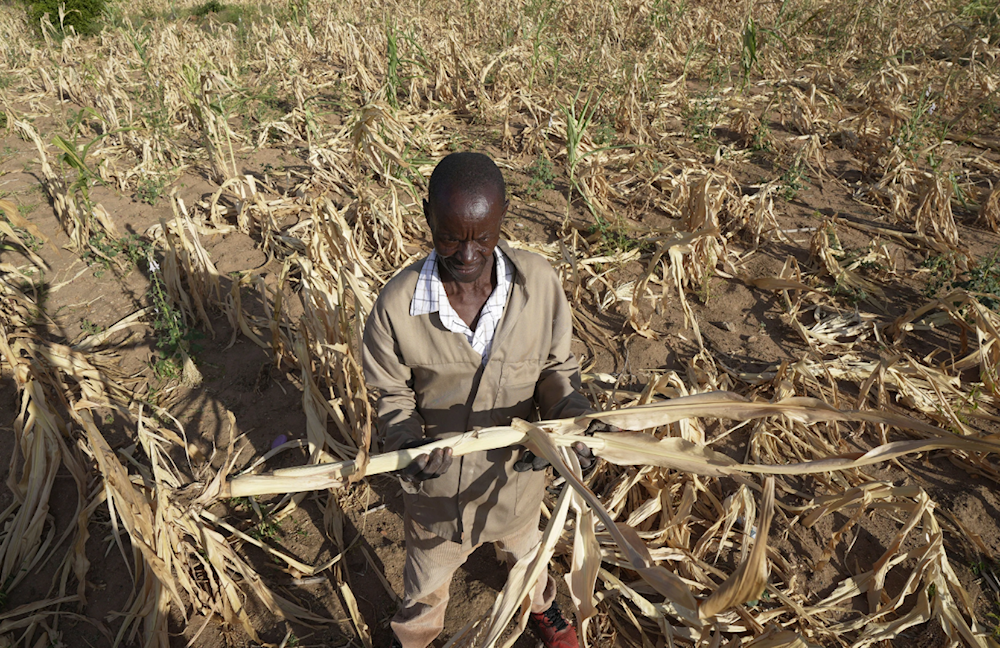Southern African drought affecting close to 68 million: SADC
Zimbabwe, Zambia, and Malawi have already declared the hunger crisis a disaster, while Namibia and Lesotho have requested humanitarian assistance.
-

James Tshuma, a farmer in Magwe district in southwestern Zimbabwe, stands in the middle of his dried up crop field amid a drouhght, in Zimbabwe on March 22, 2024. (AP)
An El Nino-induced drought has wiped out crops across Southern Africa, affecting around 68 million people, the Southern African Development Community (SADC) regional group announced on Saturday.
The drought, which began in early 2024, has hampered crop and livestock output, resulting in food shortages and harming the overall economy.
Addressing regional challenges such as food security, heads of state from the 16-nation SADC met in Zimbabwe's capital, Harare.
According to SADC executive secretary Elias Magosi, around 68 million people, or 17% of the region's population, require help.
Magosi said, "The 2024 rainy season has been a challenging one with most parts of the region experiencing negative effects of the El Nino phenomenon characterized by the late onset of rains."
The southern part of the continent is undergoing its most severe drought in years, caused by a mix of naturally occurring El Nino, which occurs when the eastern Pacific's waters warm abnormally, changing global weather patterns, and higher average temperatures caused by greenhouse gas emissions.
Zimbabwe, Zambia, and Malawi have already declared the hunger crisis a disaster, while Namibia and Lesotho have requested humanitarian assistance.
The region issued a plea in May for $5.5 billion in humanitarian assistance to help with the drought crisis, but funds have yet to arrive, according to departing SADC chair Joao Lourenco, President of Angola.
Lourenco told the summit that the amount mobilized is "unfortunately below the estimated amounts and I would like to reiterate this appeal to regional and international partners to redouble their efforts... to help our people who have been affected by El Nino,"
The drought is a prominent topic of discussion at this year's summit, as is the ongoing fighting in eastern Democratic Republic of Congo, which Lourenco described as a cause of considerable worry.
1 mln children in DR Congo at risk of famine due to years of conflict
Last month, the World Health Organization warned that over one million children in the Democratic Republic of Congo are facing a risk of acute malnutrition, adding that this was the result of increasing food insecurity after years of conflict.
WHO called the situation “catastrophic” and said that it is overwhelming water and sanitation systems, which, in turn, is leading to disease outbreaks like cholera, measles, and pox.
Environmental disasters like severe flooding and landslides, in addition to long-simmering conflicts, have left people's needs in the country soaring.
Amid escalating violence and displacement in the Democratic Republic of the Congo, hunger & malnutrition are spiking.@UNICEF is providing vital assistance to vulnerable families, transforming lives and restoring hope. https://t.co/w1hxq3RKui pic.twitter.com/bMF7HxHJ59
— United Nations (@UN) May 27, 2024
According to WHO, the African nation with over 25 million people impacted has the world’s highest number of people in need of humanitarian aid amid severe underfunding.
It noted that aid is "severely constrained by military presence around displacement sites and health facilities, bureaucratic impediments, and roadblocks disrupting aid delivery," as it urged immediate action and “sustained and unimpeded access” to basic needs while calling on parties to work together to restore peace.

 3 Min Read
3 Min Read








